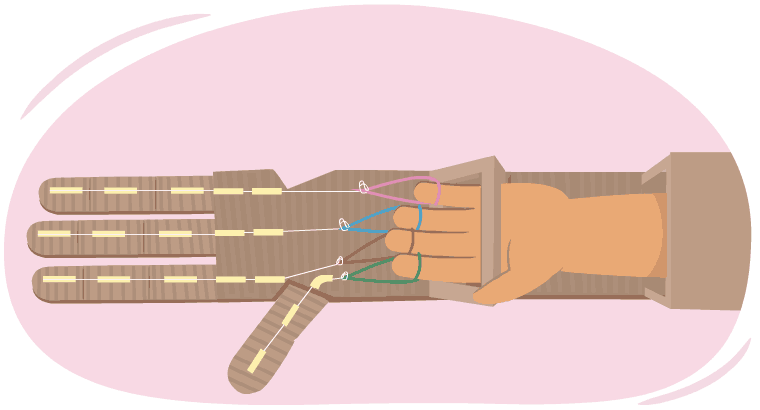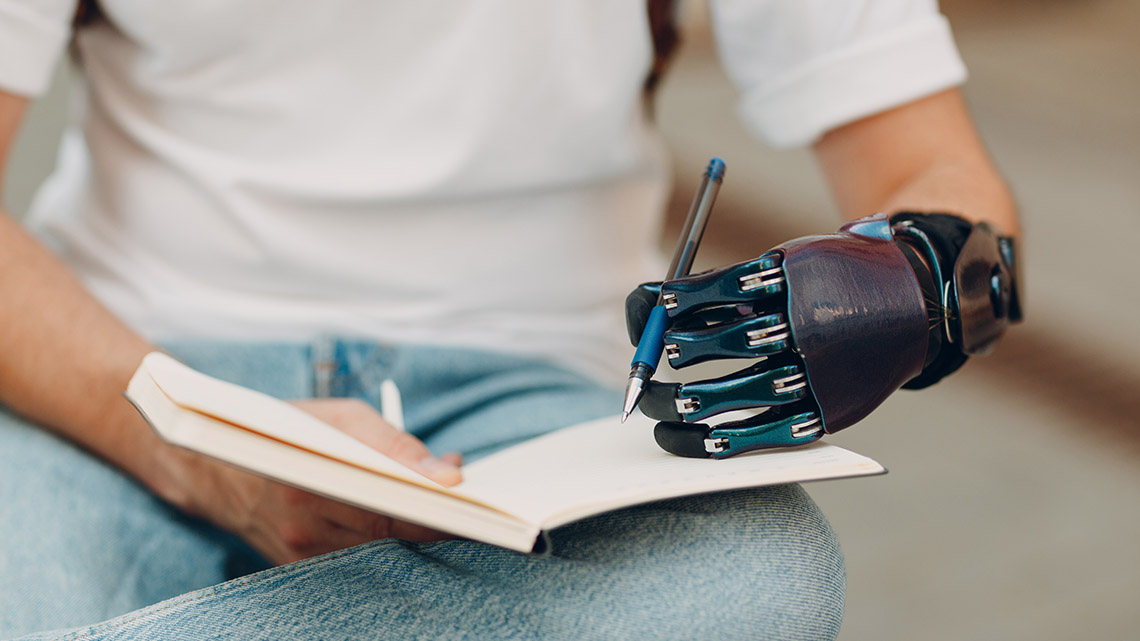Minds On
Innovations in Canada
This learning activity features emerging technologies, STEM contributions, and Canadian innovations that are making a difference.

Explore this video of a robot arm. What do you notice about the movement of the arm? What are some of the movements you think this arm may be able to perform? Do you think it can fully extend? Bend? Rotate?
Record your thoughts in a method of your choice.
Action
Bioengineering

What do you think bio (biology) means?
Press ’Let’s Check’ to reveal some answers.
- the study of life and natural sciences that focuses on living organisms and how they interact with each other and their environment
- the study of the environment
- the study of living organisms and living systems
What do you think engineering is? What do you think it means to be an engineer?
Press ’Let’s Check’ to reveal some answers.
A technical profession that solves problems by applying skills in:
- math
- science
- technology
- anatomy
- environmental studies
Bioengineering addresses challenges in the fields of biology and medicine. Bioengineering applies engineering design processes to model any living systems.
Can you think of any products that have been bioengineered?
Press ’Hint’ to reveal a clue.
Think about what types of technologies exist that are designed to function like living systems.
Examples of products that have been bioengineered are:
- prosthetic joints (artificial joints)
- prosthetic limbs (artificial limbs)
- hearing aids
- artificial organs – heart, lungs, etc.
- dialysis machines (a machine that acts as a kidney)
- contact lenses
- food products
Reflect
How do you think could bioengineering positively impact a person’s everyday life?
Who might benefit from this technology?
Record your ideas in a method of your choice.
Did you know?
What are biomechanics?
Biomechanics is understanding how a living organism moves and interacts with the environment it lives in.

Biomechanics can include:
- creating a model of a human or animal joint
- creating a prosthesis – arm, leg, knee, elbow, teeth, hip
- developing robotics to mimic human or animal movement with computer precision
- helping to improve performance in sport
- helping to avoid injury or recover from an injury
Task 1: Body systems in the hand
The body’s musculoskeletal system combines the muscular system and skeletal system. Together they are in charge of the body’s movement.
Muscles, bones, and joints are attached to each other by tissues in the body. Ligaments hold the body’s bones together and tendons connect the muscles to the bones.
Did you know that the human hand has 27 bones and 30 muscles?
In humans, the hand can perform many tasks.
What tasks can hands do? Record a list of tasks that hands are able to perform.
Press ‘Sample Answer’ to access tasks that hands can do.
Hands are able to carry, push, point, hold, scoop, pull, pick up objects, and feel
The anatomy of the hand
Explore the bones in the hand, where they begin, where they end and how they are attached to each other. The joints are the places where two bones are joined together.

A skeletal image of the hand. Each finger has 4 bones, and the thumb has 3 bones. They are attached together by a joint. The palm and back of the hand area has 7 small bones attached together and the wrist bones are close, but the bones are not attached together. The joints are where the bones come together.
Record your observations about the bones in the hand.
The muscular system of the hand
Next, explore the muscles, tendons, and ligaments in the hand, where they begin, where they end and how they are attached to each other. The muscles are the larger, darker markings in the palm and back of the hand. The tendons cover the bones and hold them together. The ligaments hold the muscles together.

This image of the hand shows the bones of the fingers, the palm and the wrist covered in muscles, in the palm area and the base of the thumb and wrist. The ligaments stretch from the base of the palm of the hand to the tips of the fingers and thumbs and into the wrist area on the perimeter.
Record your observations about the muscles, tendons, and ligaments in the hand.
Use your learning to answer these true/false questions about the musculoskeletal system and the human hand.
Select the correct answer, then press ‘Check Answer’ to see how you did.
Think about it!
How do the skeletal system and muscular system work together in the human hand?
Record your answer in a method of your choice.
Bionic bodies
When bioengineers are designing robotic hands or prosthetic (artificial) hands, they try to copy the movements of the hand. This means that they would work to replicate or copy the muscles and the bone structure so the hand could function as close to a real hand as possible.
Explore this clip of a robotic hand.
Now explore a clip of a human hand opening and closing.
How similar are the movements in both these videos?
Record your answer in a method of your choice.
Task 2: Design a bionic hand
For this activity, you are going to become a bioengineer!
Your task will be to design a bionic hand using materials found in your learning space that can pick up an item.
Before beginning your design, explore this video that explains the steps involved in the Engineering Design Process.
Before we start to design, let’s explore with Zoey as they try to build a model of a bionic hand.
Take note of which materials they use.
Answer the following question about information in the video.
Select the correct answer, then press ‘Check Answer’ to see how you did.
Your design!
What materials can be used to create your design of a bionic hand?
Consider the following examples. You can choose your own materials if you wish.
- cardboard
- string
- rubber bands of different sizes
- straws
- penne or rigatoni pasta
Consider how your materials will work together to be able to pick an item up.
Record your design plan, materials, and details of how your design will function in a method of your choice.
If possible, build your bionic hand design.
For inspiration, let’s explore an image of a handmade bionic hand. How will your bionic hand be similar or different?

A bionic hand made out of cardboard. The cardboard is in the shape of a hand. It has a handle that the hand fits under. On four of the fingers are elastic bands. The elastic bands are connected to string. The string is threaded through pasta on the fingers and thumb. The pasta represents the joints in the hand.
Consolidation
Bringing it all together

Explore this video of Matthew James, a teenage motor racing fan who has received a bionic hand from the race team.
As you explore, consider your own bionic hand design, the body systems discussed and how bioengineering works.
Think about it!
Answer the following questions in a method of your choice.
- How will this bioengineering design help Matthew while racing?
- What body systems were copied in this design?
- What technology did the bioengineer for Mercedes use to create this bionic hand for Matthew?
- If you were to show Matthew your engineering design, what is the most important thing you would like to share with him about the design? Why?
Reflection
As you read through these descriptions, which sentence best describes how you are feeling about your understanding of this learning activity? Press the button that is beside this sentence.
I feel…
Now, record your ideas using a voice recorder, speech-to-text, or writing tool.